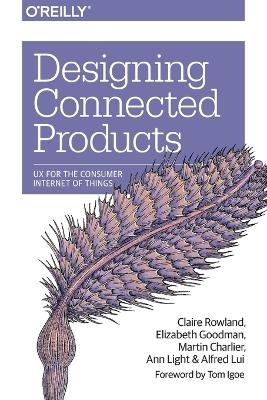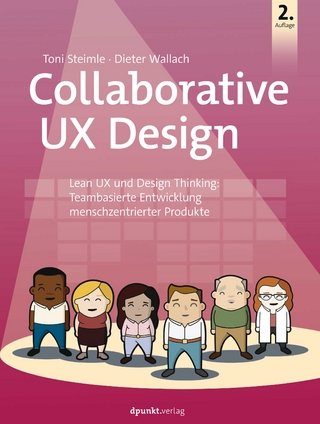
Designing Connected Products
O'Reilly Media (Verlag)
978-1-4493-7256-9 (ISBN)
This book provides experienced UX designers and technologists with a clear and practical roadmap for approaching consumer product strategy and design in this novel market. By drawing on the best of current design practice and academic research, Designing Connected Products delivers sound advice for working with cross-device interactions and the complex ecosystems inherent in IoT technology.
The Internet of Things (IoT) promises a wealth of new possibilities for interacting with the world around us. But it is still an immature and technology-driven field, and there are many barriers to creating compelling consumer products.
This book explains in simple terms what the challenges are and explores practical solutions for solving them. Drawing on the best of current design practice and academic research, Designing Connected Products provides an introduction to the technology of IoT and practical guidance on designing for diverse devices, cross-device interactions, and complex ecosystems.
UX for connected devices is about much more than UI and interaction design.
It requires you to think about interusability, industrial design, conceptual models, productization, and platform design.
This book provides a clear and practical roadmap for approaching product strategy and design in this novel market, suitable for both UX design and technology experts.
Claire Rowland is an independent UX design, research and product strategy consultant working on internet of things products and services for mainstream consumers. She has a particular interest in the use of technology in mundane, everyday activities. Previously, she worked on energy management and home automation services as the service design manager for AlertMe.com, a connected home platform provider. Prior to this, she was Head of Research for the London studio of design consultancy Fjord, where she led Fjord's involvement in the Smarcos EU consortium researching the interusability of interconnected embedded devices and services. She has worked in UX design and research for mobile, multiplatform and web services since 1997.
Elizabeth Goodman's design, research, and writing investigates the possibilities and perils of emerging technologies. Most recently, she authored the second edition of Observing the User Experience, a widely-used handbook of design research methods. She has worked with exploratory user experience research teams at Intel, Yahoo!, and Fuji-Xerox. She has a PhD from UC Berkeley's School of Information, where her scholarly research in human-computer interaction was supported by a National Science Foundation Graduate Fellowship and an Intel PhD Fellowship. Currently, she works at 18F, a service and product design group within the US government aimed at making federal agencies more efficient, more transparent, more accessible, and more accountable to the people they serve. Elizabeth speaks widely on the design of mobile and pervasive computing systems at conferences, schools, and businesses.
German-born Martin Charlier is an independent design consultant based in London. Martin is a designer with experience across new media art, industrial design, interaction design and design research. His speculative design work has been awarded by the Royal Society of Arts, and he is a fellow of the organization. He has previously worked at innovation firm frog design, cutting-edge art collective rAndom International and digital service design consultancy Fjord. While at Fjord he was involved in the EU-funded Smarcos research project investigating design for the Internet of Things. With his broad range of design skills, Martin's focus is on holistic product and service experiences going across the digital and the physical.
Alfred Lui has been a user experience designer for consumer products since 2004. He created user interfaces and digital services for companies around the world, including The BBC, Motorola, PayPal and Jawbone. In London, he was part of a EU-funded research project to investigate best practices in designing networked objects. Soon after he moved to San Francisco in 2011, he founded the San Francisco Internet of Things Meetup to build a local community around the topic. Alfred frequently writes and speaks about user experience design for the Internet of Things.
Chapter 1 What’s Different About User Experience Design for the Internet of Things?
How Is UX for IoT Different?
A Design Model for IoT
Summary
Chapter 2 Things: The Technology of Connected Devices
Types of Connected Device
Multipurpose Computers
Bridging Physical and Digital: Sensors and Actuators
The Challenge of Powering Devices
Conserving Battery Life
Summary
Chapter 3 Networks: The Technology of Connectivity
Why is Networking Relevant to IoT UX?
Networking Issues That Cause UX Challenges for IoT
The Architecture of the Internet of Things
Types of Network
Network Communication Patterns
Internet Service
Summary
Case Study 1: Proteus Digital Health: The Connected Pill
Chapter 4 Product/Service Definition and Strategy
Making Good Products
From Innovation to Mass Market
Tools Versus Products
What Makes a Good Product?
Services in IoT
Business Models
Summary
Chapter 5 Understanding People and Context
The Role of Research in Connected Product Design
Initial Questions and Concepts
Techniques: From Asking to Watching to Making
Summary
Chapter 6 Translating Research into Product Definitions
Generating the Elevator Pitch
Why Does Your Product Matter?
What Is Your Product?
What Does the Product Do?
Recurring Questions for Product Strategy
Summary
Case Study 2: Little Kelham: Connected Home
Chapter 7 Embedded Device Design
An Introduction to Thinking About Physical Objects in IoT
Making Stuff: Differences to UX
Essentials of the Design Process
Three Faces of a Physical Product
Summary
Chapter 8 Interface and Interaction Design
Types of Interaction
IoT-Specific Challenges and Opportunities
Universal Design and Accessibility
Summary
Case Study 3: Ford SYNC 3: Connected Car
Chapter 9 Cross-Device Interactions and Interusability
Cross-Platform UX and Usability
What Is Interusability?
Conceptual Models and Composition
Consistency
Continuity
Summary
Chapter 10 Interoperability
The CompuServe of Things
What Is Interoperability and Why Is It a Problem?
How Can Devices Interoperate?
How Can We Improve Interoperability?
The UX of Interoperability
Summary
Case Study 4: LOOP: Connected Pelvic Floor Exerciser
Chapter 11 Responsible IoT Design
Security
Privacy
Social Engineering
Environment
Summary
Chapter 12 Supporting Key Interactions
Setup
In-Life Housekeeping
Discovery
Control Experiences
Platforms
The Technology of Getting Things Connected
Summary
Case Study 5: BRCK: Rugged Portable WiFi Hotspot
Chapter 13 Designing with Data
Introduction
Data in IoT
Types of Data-Driven Product
What This Means for Design
Summary
Chapter 14 Iterative Design: Prototyping and Learning
The Necessity of Working Iteratively
Using Prototypes to Answer Questions
How Do You Decide What to Prototype?
Evaluation: Success Demands Failure
Summary
Chapter 15 Designing Complex, Interconnected Products and Services
It’s Complicated...
Scaling the UX
Control
Approaches to Managing Complexity
Summary
Appendix Companies, Products, and Links
Appendix About the Authors
| Erscheint lt. Verlag | 30.6.2015 |
|---|---|
| Vorwort | Tom Igoe |
| Zusatzinfo | colour illustrations |
| Verlagsort | Sebastopol |
| Sprache | englisch |
| Maße | 152 x 229 mm |
| Gewicht | 953 g |
| Einbandart | Paperback |
| Themenwelt | Mathematik / Informatik ► Informatik ► Netzwerke |
| Informatik ► Software Entwicklung ► User Interfaces (HCI) | |
| Informatik ► Weitere Themen ► Hardware | |
| Wirtschaft ► Betriebswirtschaft / Management ► Logistik / Produktion | |
| Schlagworte | Internet of Things (IoT) • UX Design • Vernetztes Haus |
| ISBN-10 | 1-4493-7256-2 / 1449372562 |
| ISBN-13 | 978-1-4493-7256-9 / 9781449372569 |
| Zustand | Neuware |
| Haben Sie eine Frage zum Produkt? |
aus dem Bereich


